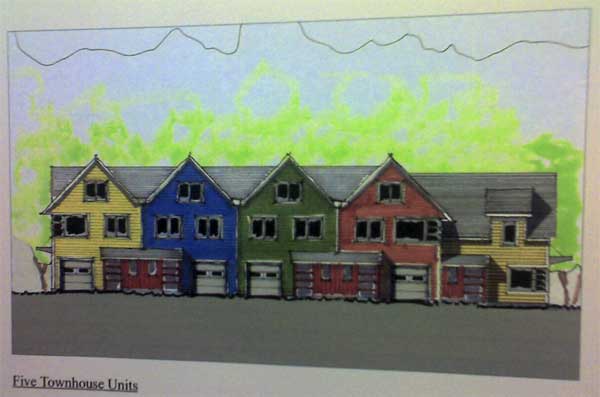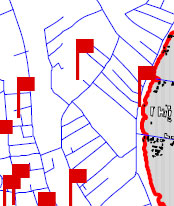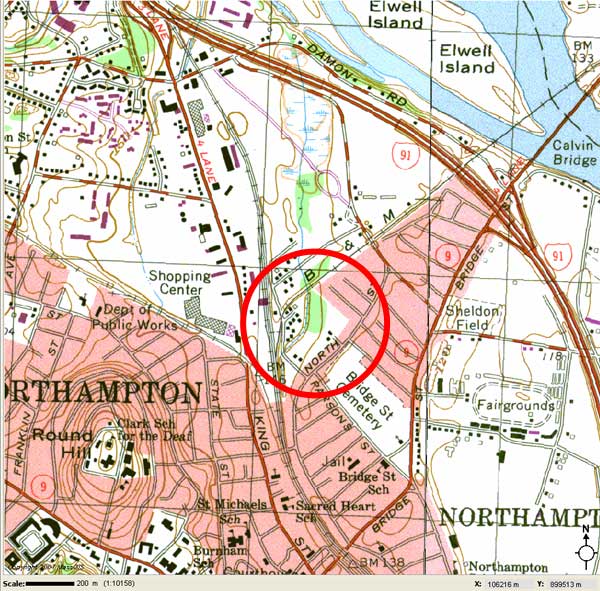As Kohl Construction endeavors to inject a cluster of cookie-cutter condos into one of the last substantial stands of trees near downtown Northampton, hoping that elaborate stormwater mitigation schemes will keep this swampy ground safe and unpolluted, The Prince of Wales gave a speech to the Foreign Press Association in London on November 25. To unsustainably eat into our natural assets, says Prince Charles, is wrong, as is a disdain for complexity and an excessive faith in technology’s power to control our surroundings. Some excerpts:
I’m sure there are many people who know that it is wrong to plunder the Earth’s treasures as recklessly as we do, but the comprehensive world view which we now inhabit persuades us that such destruction is justified because of the freedom it brings us, not to say the profits. In other words, our tendency to consume is legitimized by a view of the world that puts Humanity at the centre of things, operating with an absolute right over Nature. And that makes it a very dangerous world view indeed…
By the arrival of Modernism the West had been held in the sway of a mechanical way of thinking for over two hundred years… the ground was laid for the arrival of those straight, efficient lines of Modernism with the aim of simplifying and standardizing the world, making things as efficient and as convenient as possible…
…complexity is actually key to life. The diversity that made up this complexity was bulldozed away in the pursuit of simplicity, of increasing uniform monoculturalism and, above all else, convenience, creating an instant appeal that continues to fuel the conspicuous consumption and throwaway societies we now see everywhere…
By positioning ourselves outside Nature and believing ourselves to be free without limit to manipulate and control her constituent parts, imagining somehow that the whole will not suffer and can take care of itself whatever we do to its separate parts, we have abstracted life altogether to the extent that our urbanized mentality is now out of tune with the key principles under-pinning the health of any economy and of all life on Earth. And those principles make up what is known as “Harmony”…
…we have either ignored or simply forgotten how profoundly “health” depends upon organisms operating in harmony with their surroundings and within the cyclical rhythms of Nature…
In cutting ourselves off from Nature we cut ourselves off, more and more, from what we are…
See also:
Kohl Construction Applies for Special Permit and Site Plan Review
Seeing Like a State: Planning Gone Awry in the 20th Century
Cities tend to be complex organisms, Scott observes, so planners are constantly tempted to try to simplify their task:
Once the desire for comprehensive urban planning is
established, the logic of uniformity and regimentation is well-nigh
inexorable. Cost effectiveness contributes to this tendency… [E]very
concession to diversity is likely to entail a corresponding increase in
administrative time and budgetary cost… (p.141-142)
In Northampton, the simplification du jour appears to be a drive to segregate our open space to the periphery, while weakening greenspace preservation in the more urban districts where it is already scarce.
Smart Growth vs. “Smart Growth”
The Urban Land Institute includes the following among its Ten Principles for Smart Growth on the Suburban Fringe (PDF):
…According to Jim Constantine, a market specialist who does “curb
appeal” surveys for developers, “Consumers are turned off by
cookie-cutter subdivisions and the homogenous look of houses.”
Increasingly, buyers are attracted to vernacular and historical house
styles that characterize their immediate area or region…
Alas, developers often seize on convenient aspects of Smart Growth that
align with their profit goals and disregard others. A common result
appears to be overlarge developments, inapt developments, and/or
excessive density. These are major bones of contention in Los Angeles and Berkeley, to give two examples.
A Northampton example of this phenomenon is Kohl Construction’s proposal…

The problems with Kohl’s condo proposal include:
- It threatens green infrastructure by putting roads and structures as close as 35 feet or less to a wetland. Scientific evidence
indicates that substantial disturbance within 50 feet puts wetland
ecology at risk and threatens water quality. In addition, the condos
themselves appear to be at risk of flooding. - It goes against the existing character and diversity of housing stock in the neighborhood by offering a monotonous, cookie-cutter design scheme with little sense of place.
- As Daryl LaFleur
observes, “the Kohl North Street area development proposal includes row
house condominiums set to the rear of parking lots, not free standing
detached single family homes that front the ‘street’, which would
better match the existing neighborhood and is also a tenet of Smart
Growth.”
Smart Growth is most palatable when it’s
implemented as a whole. When public and private actors are allowed to
cherry pick aspects that suit their convenience, the “Smart” can be
lost.
Condo Monotony: The Future of Ward 3?
To maximize profits, the developers have shoehorned units into their
lots with little regard to the preexisting appearance of their
neighborhoods. The developments feel inward-facing or ‘withdrawn’, not
part of the regular street fabric. These aspects are probably what
prompted the “carbuncle” comment from the planning board member.
Northampton’s
Flood and Natural Hazard Mitigation Plan: Floyd Flood Damage Reported
Behind View Avenue; Avoid Building on Filled Wetlands
In the map
below, the red flag behind View Avenue (the topmost flag) indicates a
flood damage report from Tropical Storm Floyd (1999). This area is in
the eastern portion of Kohl Construction’s proposed condo site, one of the more elevated portions. We infer that much of Kohl’s property may be at risk from heavy rainfall events.

EPA: Wetlands and Flood Protection
Wetlands
within and downstream of urban areas are particularly valuable,
counteracting the greatly increased rate and volume of surface-water
runoff from pavement and buildings…
Photo Essay: 10 Reasons People Like Trees Around Them; Will the Sustainable Northampton Plan
Put Urban Trees at Risk?
“Planning for Trees” by Henry Arnold, Planning Commissioners Journal, January/February 1992
A
recent survey by the American Forestry Association of twenty American
cities found that, on average, only one tree is planted for every four
removed…
Our urban centers need to become more attractive to
help counter the continuation of a sprawl pattern of development. If
the appeal of low density, widely scattered development is derived from
the need to be closer to nature, then making trees an integral part of
the urban habitat will help make our town and city centers more
desirable places to live and work. It is profoundly important to see
this linkage between making cities and towns more “liveable” and
stemming the continued spread of scattered development across the
countryside…
“Green Enhances Growth” by Edward T. McMahon, Planning Commissioners Journal, Spring 1996
…[A
1995 survey by American Lives shows] that “consumers are putting an
increasingly high premium on interaction with the outdoor environment
through the inclusion of wooded tracts, nature paths, and even
wilderness areas in housing developments.” In fact, 77 percent of
consumers put “natural open space” as the feature they desired most in
a new home development.
“Growing Greener: Conservation Subdivision Design” by Randall Arendt, Planning Commissioners Journal, Winter 1999
A
national survey of homebuyers conducted in 1994 by American Lives
revealed that of 39 features critical to their choice, homebuyers
ranked “lots of natural open space” and plenty of “walking and biking
paths” as the third and fourth highest rated factors affecting their
decisions…
“On the Value of Trees and Open Space” by Elizabeth Brabec, Planning Commissioners Journal, Summer 1993
Trees
reduce air pollution by filtering dust out of the air, reduce noise and
light pollution, reduce soil erosion and water run off, and aid in
climate control. Research has shown that properly placed trees and
landscape plantings can save 20 to 25 percent of energy use in the home
for both cooling and heating…
Numerous studies have shown that
people are willing to pay more for homes that are surrounded by trees
and other landscaping. How much more? Depending on the area of the
country, anywhere from 3 to 18 percent…
“Green Infrastructure” by Edward T. McMahon, Planning Commissioners Journal, Winter 2000
Just
as communities need to upgrade and expand their gray infrastructure
(i.e. roads, sewers, utilities), so too, they need to upgrade and
expand their “green” infrastructure–the network of open space,
woodlands, wildlife habitat, parks and other natural areas, which
sustain clean air, water, and natural resources and enrich their
citizens’ quality of life…
The concept of green infrastructure
represents a dramatic shift in the way local and state governments
think about green space. In the past, many communities assumed that
open space was land that had simply not been developed yet, because no
one had filed a subdivision plan for it…
Berkeley, California: Cautions on Infill
In
1990, 60 percent of New Yorkers said they would live somewhere else if
they could, and in 2000, 70 percent of urbanites in Britain felt the
same way. Many suburbanites commute hours every day just to have “a
home, a bit of private space, and fresh air.”

Greening Smart Growth: The Sustainable Sites Initiative
The
presence of natural elements has several implications for personal and
community security. Shared green spaces, particularly those with trees,
provide settings for people to interact and strengthen social ties.
Residential areas with green surroundings are associated with greater
social cohesion in neighborhoods, and neighbors with stronger social
ties are more likely to monitor local activity, intervene if problem
behaviors occur,[48] and defend their neighborhoods against crime.[49]
Residents of buildings with greater tree and grass cover report fewer
incidences of vandalism, graffiti, and litter than counterparts in more
barren buildings.[50] Likewise, a study comparing police reports of
crime and extent of tree and grass cover found that the greener a
building’s surroundings, the fewer total crimes were reported.[51]
UMass Press: “Natural Land: Preserving and Funding Open Space”
Preserving
areas of nature, open space, and trees and other vegetation can have
psychological as well as physical health benefits for local residents.
There is a growing body of research which points to the power of nature
to restore people from the stress of modern life, including mental
fatigue (Kaplan, Kaplan, and Ryan 1998; Frumkin 2001).
The Ecological Cities Project: Greenspace in “The Humane Metropolis”
A
metropolis (i.e., metro region or citistate) is considered green if it
fosters humans’ connections to the natural world — an idea Anne
Whiston Spirn promoted in her seminal 1984 book The Granite Garden.
Spirn rejected the idea — easily absorbed if one watches too many
“concrete jungle” films, or even televised nature documentaries —
that the natural world begins beyond the urban fringe. “Nature in the
city,” she wrote, “must be cultivated, like a garden, rather than
ignored or subdued.”
Rutherford Platt, “Regreening the Metropolis: Pathways to More Ecological Cities”
…cities and metropolitan areas, now too large to conveniently escape, must themselves be viewed as incorporating both built and unbuilt
environments… And into the bargain, the urban environment will prove
to be more habitable, more sustainable, more “ecological”…
Irony of Infill: You Have to Drive to Enjoy Nature
Northampton Redoubt: Urban Ecology, Planting Trees, and the Long-Term View
People
in favor of the Kohl subdivision have argued that the North Street area
is close to city services and infrastructure plus it’s within walking
distance to downtown merchants and Bridge Street School. Since Mr. Kohl
owns downtown commercial property it makes sense for him to assist in
increasing downtown residential density from an economic development
point of view. Proponents reason that if all things were equal, five
acres of forest lost to development in-town is better than five acres
of forest lost to development in the outlying areas. This seems like a
valid view, but are all things equal?
If we remove all of our
in-town forested areas and wetlands they will likely be gone forever or
at least a very long time. We would do well for posterity to err on the
side of caution. For example the cost estimate to restore part of the
downtown historic Mill River channel runs into the millions of dollars.
Had the river’s diversion in the 1940s been handled differently,
perhaps with a sharper eye towards the future, maybe today we wouldn’t
be searching for dollars to make its restoration a reality.
There
are other aspects of urban ecology that are important as well and we
should examine these closely. For instance urban forests provide
habitat for birds and small creatures that consume mosquitoes and other
insects. Urban forests help to keep our air cleaner by removing
pollutants from the atmosphere. They also reduce the size of urban heat
islands thereby lessening our need to run air conditioners and fans
which traditionally burn fossil fuels.